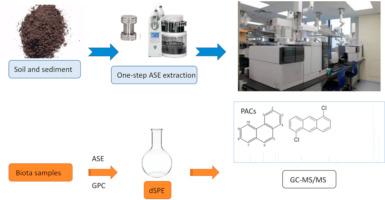Chemosphere ( IF 8.1 ) Pub Date : 2021-01-23 , DOI: 10.1016/j.chemosphere.2021.129738 Zhe Xia , Ifeoluwa Idowu , Evan Kerr , Nicole Klaassen , Harsimran Assi , Harley Bray , Chris Marvin , Philippe J. Thomas , Jorg Stetefeld , Gregg T. Tomy

|
This study validates two approaches to streamlining the processing of sediment and biota for a suite of polycyclic aromatic compounds (PACs) with a wide range of chemical properties, including polycyclic aromatic hydrocarbons (PAHs) and alkyl-PAHs (APAHs), and a new class of environmental contaminants, halogenated PAHs (HPAHs). One method is based on one-step in situ extraction/cleanup using accelerated solvent extraction (ASE) in which a mixture of copper, deactivated alumina and silica gel were added directly to the ASE cell along with sample; the second technique is based on dispersive solid phase extraction (dSPE) using alumina/silica for cleanup of biota samples to augment conventional ASE extraction combined with gel permeation chromatography. Validation protocols were performed in accordance with the ISO/IEC 17025 guidelines, whereby method performance characteristics, i.e., accuracy, precision, linearity, limits of detection and ruggedness, were evaluated. Accuracies generally ranged from 70 to 120% for the in situ ASE method and 70–100% for the dSPE technique. Limits of detection/quantitation for the 45 target analytes for in situ ASE and dSPE methods were determined to be < 2.5/8 pg μL−1, and < 20/60 pg μL−1, respectively. Intra- and inter-day repeatability for both methods were < 25% except for 1 APAH which had an inter-day precision of 35% using the dSPE method. Neither method was affected by any of the purposeful changes attempted which implies that both methods are robust. Results of our validation studies showed excellent data quality for both methods in addition to achieving a reduction in sample processing times.
中文翻译:

减少样品处理时间以确定环境样品中多环芳族化合物的新方法
这项研究验证了两种简化一系列含多种化学性质的多环芳族化合物(PAC)的沉积物和生物区系的方法,包括多环芳烃(PAHs)和烷基-PAHs(APAHs),以及一个新类别环境污染物,卤代多环芳烃(HPAH)。一种方法是基于原位一步使用加速溶剂萃取(ASE)进行萃取/净化,其中将铜,钝化氧化铝和硅胶的混合物与样品一起直接添加到ASE池中;第二种技术基于使用氧化铝/二氧化硅的分散固相萃取(dSPE)净化生物样品,以增强常规ASE萃取与凝胶渗透色谱法的结合。根据ISO / IEC 17025指南执行验证协议,从而评估方法的性能特征,即准确性,精确度,线性,检测极限和坚固性。原位ASE方法的准确度通常在70%至120 %之间,而dSPE技术的准确度通常在70%至100%之间。45种目标分析物的原位检测/定量限ASE和dSPE方法分别确定为<2.5 / 8 pgμL -1和<20/60 pgμL -1。两种方法的日间和日间重复性均<25%,不同之处在于使用dSPE方法的1个APAH日间精度为35%。两种方法都不受尝试的任何有意更改的影响,这暗示着这两种方法都是可靠的。我们的验证研究结果表明,除了可以减少样品处理时间之外,这两种方法的数据质量都很高。











































 京公网安备 11010802027423号
京公网安备 11010802027423号